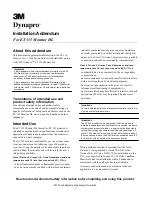
Description of the patented intermittent earth fault algorithm.
The algorithm relates to a method for identifying transient-type earth faults in an electrical network and
for selectively tripping a faulty branch line (A/D). The absolute value (I0
max
) and its index in a zero-
current buffer are retrieved from the samples of a zero-current sampling buffer. This is done by means
of value-depicting the admittance-delta which is calculated using the ratio DELTAl0/DELTAU0: that is,
the ratio between the zero current l0 difference DELTAI0 and the residual voltage UC difference
DELTAU0. A negative admittance-delta is classi ed as forward (FWD). A transient-type earth fault is
detected in the branch line with the aid of at least one forward (FWD) spike during a selected time
(FWDreset).
More detailed information of the patent can be found on the European Patent Of ce webpages. The
patent's data code is EP3213381 (A1).
A link to the patent: https://worldwide.espacenet.com/publicationDetails/biblio?
II=2&ND=3&adjacent=true&locale=en_EP&FT=D&date=20170906&CC=EP&NR=3213381A1&KC=A1.
Setting principles
The intermittent earth fault protection will be coordinated with bus bar residual voltage protection. This
way, during an intermittent earth fault, a faulty feeder's protection function will trip in all three previously
described scenarios. Also, an intermittent earth fault protection function tripping before the residual
voltage protection function results in a suf cient safety margin. However, since an intermittent earth
fault causes signi cant network stress the protection trip should be performed as fast as possible.
The strike-through time of an intermittent earth fault in a network tuned close to resonance sets the
limit for the minimum operating time for an intermittent earth fault protection stage. To ensure a correct
protection operation in all cases, the reset time of an intermittent earth fault stage will be set according
to the network in question, to such a level that ensures that the fault has disappeared and no new
strike-throughs are expected after a prescribed reset time.
The size of the network is a dominant factor in de ning the time interval of a strike-through. One can
expect less frequent strike-throughs in larger (in amperes) networks. The following can be presented
as a rule of a thumb: in a small or medium size network (<60 A) the strike-through interval is
appr. 250...350 ms, in a large network (~100 A) it is appr. 500 ms. It is recommended that the reset
time of an intermittent earth fault stage should not be set lower than 450 ms in order to obtain a
network independent setting. Using this recommended value one can ensure that the function will not
reset too early even in resonance tuned networks.
Usually the maximum operating time of an intermittent earth fault function is dictated by the residual
voltage protection of the bus bar. If the residual voltage protection is set to very fast tripping, it may be
necessary to also prolong its set value. It is recommended that the operating time of an intermittent
earth fault stage should be 500 ms counting from the rst strike-through. Using this recommended
value the protection tripping requires a minimum of two strike-troughs even in resonance tuned
networks in which strike-throughs occur less frequently. If the residual voltage protection is set to very
fast tripping (<1 s), it may be necessary to verify the reset value of the residual voltage protection. The
residual voltage protection operating time will never be faster than the sum of the following: the
prescribed intermittent earth fault operating time, the circuit breaker operating time, and the reset time
of the residual voltage protection stage.
If an intermittent earth fault protection start is used to block regular non-intermittent directional earth
fault protection, the blocking should be applied to both healthy and faulty feeder relays. In general, if
intermittent earth fault protection is not used to block directional earth fault protection, it should be
veri ed that the operating time of regular directional earth fault protection is longer than the set
intermittent earth fault protection operating time. It is recommended to block regular directional earth
fault protection to avoid start events in directional earth fault protection during intermittent earth faults
(if start events are considered disturbing), or if directional non-intermittent earth fault protection is set
to a faster operating time than intermittent earth fault protection.
AQ-E215
Instruction manual
Version: 2.01
83
© Arcteq Relays Ltd
















































